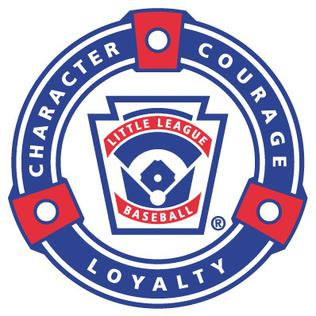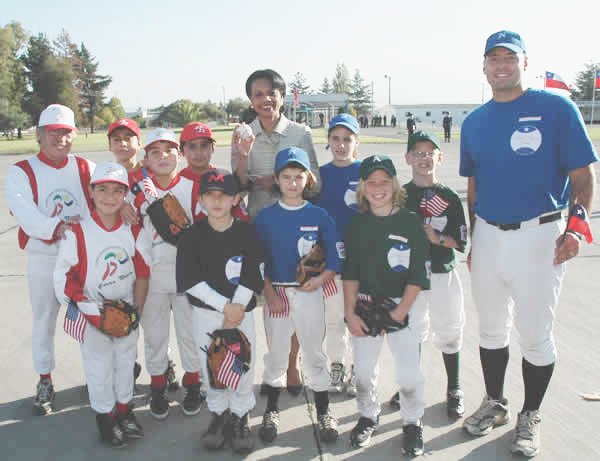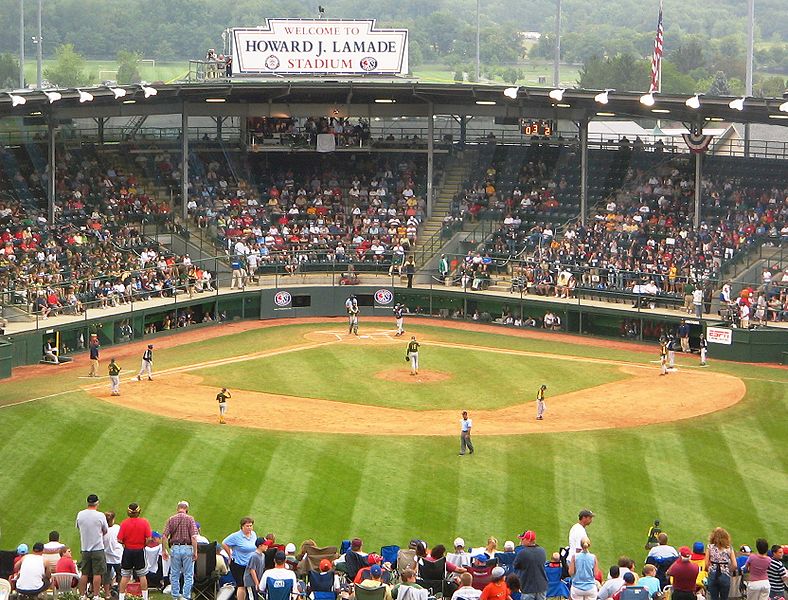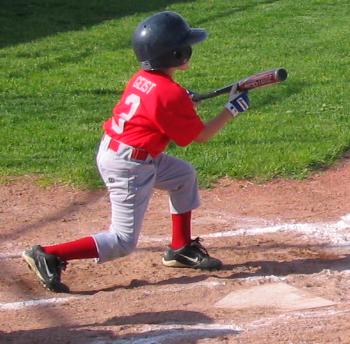Little League Baseball and Softball (officially, Little League Baseball Inc.) is a 501(c)(3) nonprofit organization with headquarters in South Williamsport, Pennsylvania, in the United States. It coordinates regional youth baseball and softball leagues across the country and around the globe.
Little League Baseball was established by Carl Stotz in Williamsport, Pennsylvania, as a three-team league in 1939, and it was legally organized on October 10, 1950. Little League Baseball promotes neighborhood volunteers to run Little League programs that are yearly authorized via Little League International. Each league can organize itself in a way that best serves the kids in the community where it operates. Children and teenagers ages 4 to 16 can participate in Little League baseball and softball at several distinct levels. A congressional charter is in place for the organization under Title 36 of the United States Code.
The administrative headquarters of the company is in South Williamsport. Williamsport hosted the 1947 Little League Baseball World Series. At Howard J. Lamade Stadium and Little League Volunteer Stadium, the Little League International Complex is home to the annual Little League Baseball World Series. It also houses the Peter J. McGovern Little League Museum, which features kid-friendly interactive exhibits that tell the story of Little League Baseball and Softball. Many players in Major League Baseball (MLB) were Little Leaguers.
History
Little League Baseball was started in 1939 by Williamsport, Pennsylvania native Carl Stotz. In the summer of 1938, he collected his nephews Jimmy and Major Gehron and their friends from the neighborhood to test out his concept. Over the course of the summer, they experimented with various field sizes and participated in several unorganized games. They believed they were prepared to start what would eventually become Little League Baseball the following summer. In Williamsport’s initial league, there were just three teams, each of which was supported by a different company. Stotz and the Bebble brothers led the initial iterations of the Jumbo Pretzel, Lycoming Dairy, and Lundy Lumber sports franchises. They established the first Little League board of directors, which was later joined by their wives and another couple.
On June 6, 1939, Lundy Lumber and Lycoming Dairy played in the first league match, in which Lundy Lumber won 23-8. The first-half champions of the season, Lycoming Dairy, then defeated the second-half champions, Lundy Lumber, in a best-of-three championship series. The next year, a second league was established in Williamsport, and from that point on, Little League Baseball expanded to become a global organization with approximately 200,000 teams in all 50 states of the United States and more than 80 other nations.
Little League was exclusively open to boys from 1951 until 1973. Following the outcome of a lawsuit brought by the National Organization for Women on behalf of Maria Pepe, Little League regulations were changed in 1974 to permit females to participate in the baseball program.
Around 2.6 million boys and girls participated in Little League Baseball globally. Boys and girls that have signed up for softball leagues amount close to 400,000. Starting in 2022, Little League Baseball will be divided into 20 geographical zones, 10 national and 10 international, for tournament purposes. Each summer, Little League hosts seven World Series tournaments (Little League baseball, Little League softball, Junior, Senior, Big-League baseball, and softball) at various locations across the country.
Timeline
1939: Carl Stotz establishes Little League Baseball in Williamsport, Pennsylvania, in 1939. On June 6, 1939, the first official game was played.
1947: Williamsport hosts the inaugural Little League World Series in 1947. Only American teams are present in the competition.
1950: A Canadian team becomes the first from outside the United States to play in the Little League World Series.
1957: Saw the first Little League Baseball outside of the United States with the World Series participation of a team from Monterrey, Mexico.
1974: The first Little League Softball division that welcomed female players was created.
1992: A division of Little League is established for kids with intellectual and physical impairments.
2001: Baseball’s Little League celebrates its 60th anniversary in 2001.
2019: Little League Baseball saw the adoption of new age determination regulations for the Little League Baseball division, switching from an age cutoff based on the player’s birthday to a cutoff based on the player’s precise date of birth.
2020: The Little League season was disrupted by the COVID-19 epidemic, with some local and regional leagues postponing or canceling their events.
2021: Little League Baseball restarted in 2021.
Around 2.6 million boys and girls participated in Little League Baseball globally. Boys and girls that have signed up for softball leagues amount close to 400,000. Starting in 2022, Little League Baseball will be divided into 20 geographical zones, 10 national and 10 international, for tournament purposes. Each summer, Little League hosts seven World Series tournaments (Little League baseball, Little League softball, Junior, Senior, Big-League baseball, and softball) at various locations across the country.
Various Divisions of Little League
Tee Ball
The Little League experience can start in Tee Ball for all participants, parents, and volunteers. The Little League Tee Ball program can be set up for baseball or softball, although it is normally co-ed. Even for new parents who want to join the program with their kids as coaches, there is a fun and interesting turnkey program designed just for them. Up until the age of seven, kids can play Tee Ball before going on to the Minor Division.
Challenger Division
When you decide to join Little League, no one is left out or behind. The Challenger Division, which serves children and young people with physical and developmental disabilities, serves as the best illustration of inclusion. Challenger players (ages 4–18, or up to 22 if the player is still in school), their families, and communities have profited for 25 years from participating in Little League.
Minor Leagues
Minor Leagues is Softball and baseball for ages 7–12 years old. “Coach pitch,” “player pitch,” and “machine pitch” may each have separate divisions.
Little League® or Major League
This is both Softball and baseball for ages 8 to 12. First level with a competition for 11 and 12-year-olds on the international stage perhaps organized according to age groups.
Intermediate (50/70) Baseball
Baseball for ages 11 to 13 years old. This is a transitional program that features tournament play, a World Series, and 50-foot pitching distances and 70-foot base paths.
Junior League
Softball and baseball for 12–14 years old. For baseball, this level features tournament play, including a World Series, on a field with regular baseball dimensions (60-foot pitching distance and 90-foot base paths). For Softball, with a pitching distance of 43 feet, this category and the other Teenage Softball divisions use the same base path and fence measurements as Little League softball. It offers tournament play, including the World Series, and connects Little League and Senior League.
Senior League
Senior League is for both Softball and baseball, aged 13 to 16 years old. For baseball, this level features tournament play, including a World Series, on a field with regular baseball dimensions (60-foot pitching distance and 90-foot base paths).
For softball, Junior Division-eligible players may participate in Senior League, however, they may not dual roster. A World Series is one of the tournaments offered by the Senior League.
Boys Softball
Play takes place on fields with 60-foot base paths for Tee Ball (ages 4 to 6), Minor League (ages 7 to 11), Major League (ages 9 to 12), and Teenage Divisions. Each division has a different pitching distance. Teenage Divisions: 43 feet; Minor League: 35 feet; Major League: 40 feet.
If your child wants to try softball and eventually join various softball leagues, check out our Guide to Selecting a Fastpitch Softball Bat to know which bats are great for beginners and are durable and reliable enough to use for league games.
The Advantages of Enrolling Your Child in a Little League Team
A little league team might be the ideal method for your child to become involved if they are passionate about sports. Although it is one of the many benefits, playing baseball is not the only reason to join a little league team.
The benefits of participating in this enjoyable, youth-focused team sport are numerous. Continue reading for eight reasons why having your child join a little league team can be very beneficial for them.
1. Sporting Activity Encourages Good Health
Kids often have a lot of energy, but it is getting easier and easier to burn off that energy without breaking a sweat. You may benefit your child’s health and instill the habit of exercising by enrolling them in a sport that meets frequently.
Little league players are nearly never still, whether they are in the infield or outfield. A terrific approach to raising your heart rate, developing muscles, and improving flexibility is to play baseball.
2. The Value of Teamwork is Taught in Little League
Everyone can benefit from learning how to collaborate in a team. A competent team player usually has excellent communication skills, appreciates the value of putting in their best effort, and takes greater joy in their accomplishments.
Encourage your children to exercise; it is always a good idea. However, you also aid in teaching your child the importance of collaboration when you promote fitness via team sports.
3. Baseball Training Improves Coordination
Cognitive and physical skills are still growing in pre-adolescence. This development includes hand-eye coordination, which is difficult to acquire organically.
Children continuously hone their hand-eye coordination while playing baseball. They are constantly using such mental and physical abilities, whether they are tracking down a home run or aligning their bat swing with the direction of the ball.
4. Participating in Sports Reduces Screen Time
Today’s youth are always around screens. They can spend all day staring at their phones, tablets, laptops, and televisions. They frequently have to spend hours staring at a screen to do their studies.
By enrolling your children in a little league team, you establish set periods when screens are out of the picture. Reducing screen time can help kids sleep better, have fewer mental health problems, pay attention for longer periods, and more.
5. Making Friends in Little League Is a Great Experience
Some kids are just naturally friendly and seem to meet people everywhere they go. Some people are more reserved and may find it difficult to start up a conversation with simply anyone.
Pre-teens have the chance to form relationships with other people when they are included in sports teams. Whether they wear their jersey on the field or flaunt their team pin off the field, sports teams assist kids in developing a sense of identity. Little League brings kids together and provides them with a foundation for lasting friendships.
6. Baseball Practice Teaches Sportsmanship
Although it is nice to win, it is a reality of life that we do not always succeed. Being able to tolerate defeat and even be glad for those who succeed is an important life skill.
The little league fosters an atmosphere where the game itself takes precedence over the result. In the end, your youngster gets to have fun whether they win or lose. Kids may learn how to handle defeats later in life without feeling angry, depressed, or overwhelmed by practicing losing with grace in a relatively low-stakes situation.
7. Participating in Little League Increases Confidence
Another quality that some children appear to have naturally, and others do not is confidence. At the end of the day, we all need to develop our confidence. When we develop self-assurance early in life, we may carry it into maturity.
Almost everything on this list revolves around gaining confidence. Exercise has the potential to release feel-good neurochemicals that support positive mood and emotion regulation. Being a team member may increase our emotional self-worth and sense of accomplishment when it comes to the things we set our minds to.
8. A lot of fun may be had playing for a Little League team
In the end, it is a lot of fun to play on a small league team. A fantastic approach for kids to have fun and let free is to take up a team sport. Additionally, our kids’ experiences in little league provide them with enduring, joyful memories that they will treasure forever!
Conclusion
Little League Baseball has been an important component of local communities all around the world for many years. For young athletes, it offers a priceless setting where they may learn the principles of the sport, acquire crucial life skills, and enjoy the thrill of competition.





